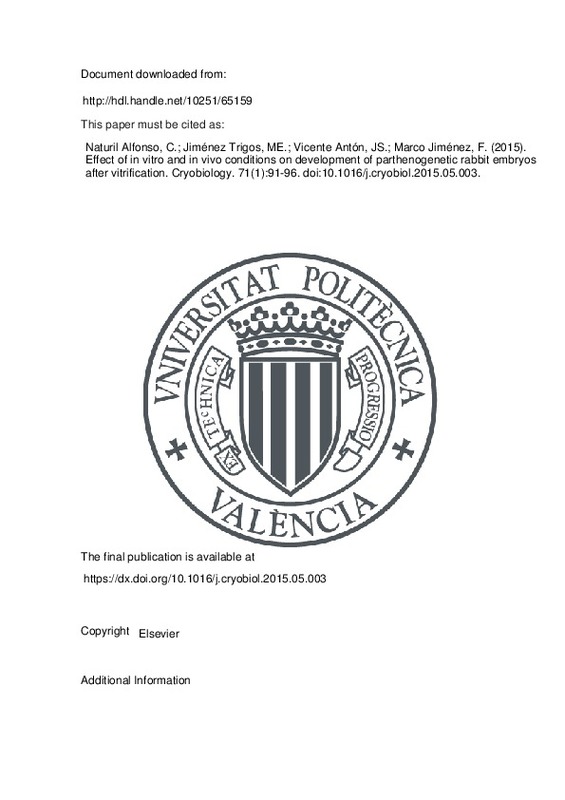JavaScript is disabled for your browser. Some features of this site may not work without it.
Buscar en RiuNet
Listar
Mi cuenta
Estadísticas
Ayuda RiuNet
Admin. UPV
Effect of in vitro and in vivo conditions on development of parthenogenetic rabbit embryos after vitrification
Mostrar el registro sencillo del ítem
Ficheros en el ítem
| dc.contributor.author | Naturil Alfonso, Carmen
|
es_ES |
| dc.contributor.author | Jiménez Trigos, María Estrella
|
es_ES |
| dc.contributor.author | Vicente Antón, José Salvador
|
es_ES |
| dc.contributor.author | Marco Jiménez, Francisco
|
es_ES |
| dc.date.accessioned | 2016-06-03T07:39:23Z | |
| dc.date.available | 2016-06-03T07:39:23Z | |
| dc.date.issued | 2015-08 | |
| dc.identifier.issn | 0011-2240 | |
| dc.identifier.uri | http://hdl.handle.net/10251/65159 | |
| dc.description.abstract | [EN] Parthenote embryos offer multiple opportunities in biotechnological research, so it is important to analyse the possibilities for their cryopreservation in order to establish a biobank. The aim of this experiment was to determine the effect of culture conditions and vitrification on rabbit parthenogenetic embryos. Parthenotes were cultured under in vivo and in vitro conditions until day 3 (late morula/early blastocyst), when they were vitrified. Immediately after warming, they were newly cultured under in vivo and in vitro conditions till day 6 (blastocyst stage). Both culture conditions showed similar late morula/early blastocyst (0.39±0.056 vs. 0.46±0.043, for in vivo and in vitro, respectively) and blastocyst rates (0.12±0.068 vs. 0.13±0.070, for in vivo and in vitro, respectively). However, no parthenote was recovered when a combination of culture conditions was performed. To our best knowledge, this is the first demonstration of the ability of rabbit parthenogenetic embryos to develop after vitrification, with similar embryo development after in vivo or in vitro culture. Nevertheless, our results highlight the importance of culture conditions on the morphology of parthenote embryos. Therefore, we have described that special attention should be paid on culture conditions to generate parthenote embryos, with a view to their subsequent use, for example in embryonic stem cell production. | es_ES |
| dc.description.sponsorship | Statement of funding: This work was supported by funds from the Generalitat Valenciana Research Programme (Prometeoll 2014/036). | en_EN |
| dc.language | Inglés | es_ES |
| dc.publisher | Elsevier | es_ES |
| dc.relation.ispartof | Cryobiology | es_ES |
| dc.rights | Reserva de todos los derechos | es_ES |
| dc.subject | In vitro | es_ES |
| dc.subject | In vivo | es_ES |
| dc.subject | Parthenogenesis | es_ES |
| dc.subject | Rabbit | es_ES |
| dc.subject | Vitrification | es_ES |
| dc.subject.classification | PRODUCCION ANIMAL | es_ES |
| dc.title | Effect of in vitro and in vivo conditions on development of parthenogenetic rabbit embryos after vitrification | es_ES |
| dc.type | Artículo | es_ES |
| dc.identifier.doi | 10.1016/j.cryobiol.2015.05.003 | |
| dc.relation.projectID | info:eu-repo/grantAgreement/GVA//PROMETEOII%2F2014%2F036/ES/Crioconservación de óvulos y embriones. Cambios epigenéticos y repercusiones transcripcionales y proteómicas/ | es_ES |
| dc.rights.accessRights | Abierto | es_ES |
| dc.contributor.affiliation | Universitat Politècnica de València. Instituto de Ciencia y Tecnología Animal - Institut de Ciència i Tecnologia Animal | es_ES |
| dc.contributor.affiliation | Universitat Politècnica de València. Departamento de Ciencia Animal - Departament de Ciència Animal | es_ES |
| dc.description.bibliographicCitation | Naturil Alfonso, C.; Jiménez Trigos, ME.; Vicente Antón, JS.; Marco Jiménez, F. (2015). Effect of in vitro and in vivo conditions on development of parthenogenetic rabbit embryos after vitrification. Cryobiology. 71(1):91-96. doi:10.1016/j.cryobiol.2015.05.003 | es_ES |
| dc.description.accrualMethod | S | es_ES |
| dc.relation.publisherversion | https://dx.doi.org/10.1016/j.cryobiol.2015.05.003 | es_ES |
| dc.description.upvformatpinicio | 91 | es_ES |
| dc.description.upvformatpfin | 96 | es_ES |
| dc.type.version | info:eu-repo/semantics/publishedVersion | es_ES |
| dc.description.volume | 71 | es_ES |
| dc.description.issue | 1 | es_ES |
| dc.relation.senia | 292337 | es_ES |
| dc.identifier.eissn | 1090-2392 | |
| dc.contributor.funder | Generalitat Valenciana | es_ES |







![[Cerrado]](/themes/UPV/images/candado.png)

